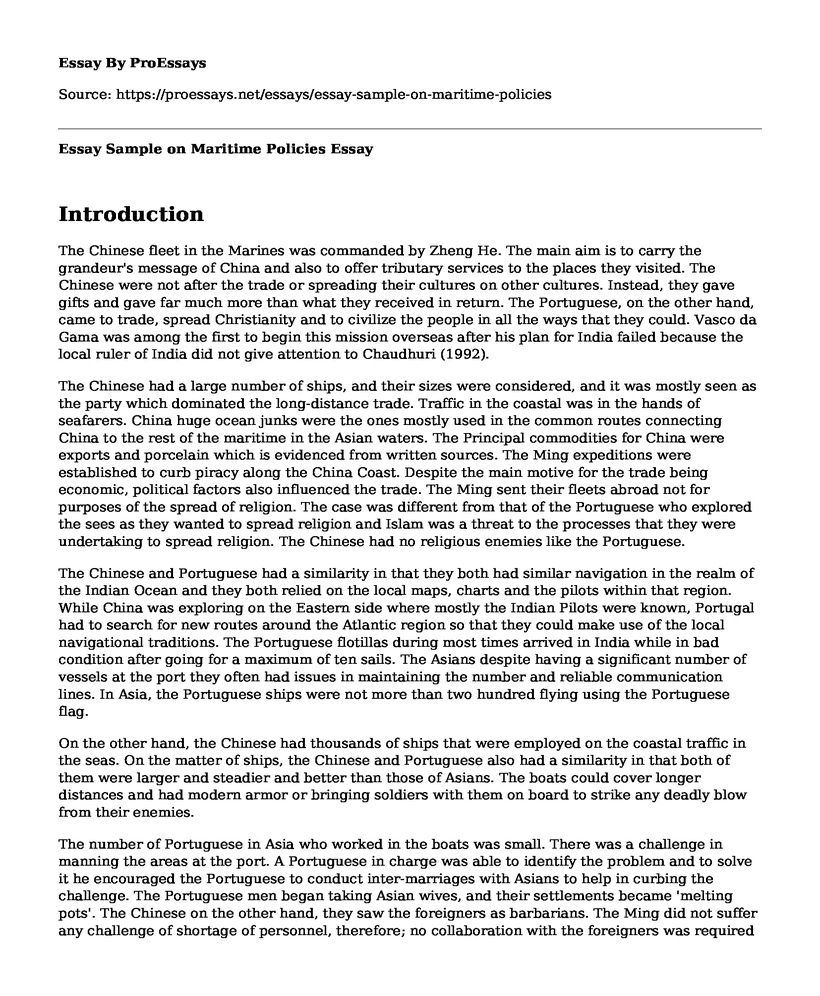Introduction
The Chinese fleet in the Marines was commanded by Zheng He. The main aim is to carry the grandeur's message of China and also to offer tributary services to the places they visited. The Chinese were not after the trade or spreading their cultures on other cultures. Instead, they gave gifts and gave far much more than what they received in return. The Portuguese, on the other hand, came to trade, spread Christianity and to civilize the people in all the ways that they could. Vasco da Gama was among the first to begin this mission overseas after his plan for India failed because the local ruler of India did not give attention to Chaudhuri (1992).
The Chinese had a large number of ships, and their sizes were considered, and it was mostly seen as the party which dominated the long-distance trade. Traffic in the coastal was in the hands of seafarers. China huge ocean junks were the ones mostly used in the common routes connecting China to the rest of the maritime in the Asian waters. The Principal commodities for China were exports and porcelain which is evidenced from written sources. The Ming expeditions were established to curb piracy along the China Coast. Despite the main motive for the trade being economic, political factors also influenced the trade. The Ming sent their fleets abroad not for purposes of the spread of religion. The case was different from that of the Portuguese who explored the sees as they wanted to spread religion and Islam was a threat to the processes that they were undertaking to spread religion. The Chinese had no religious enemies like the Portuguese.
The Chinese and Portuguese had a similarity in that they both had similar navigation in the realm of the Indian Ocean and they both relied on the local maps, charts and the pilots within that region. While China was exploring on the Eastern side where mostly the Indian Pilots were known, Portugal had to search for new routes around the Atlantic region so that they could make use of the local navigational traditions. The Portuguese flotillas during most times arrived in India while in bad condition after going for a maximum of ten sails. The Asians despite having a significant number of vessels at the port they often had issues in maintaining the number and reliable communication lines. In Asia, the Portuguese ships were not more than two hundred flying using the Portuguese flag.
On the other hand, the Chinese had thousands of ships that were employed on the coastal traffic in the seas. On the matter of ships, the Chinese and Portuguese also had a similarity in that both of them were larger and steadier and better than those of Asians. The boats could cover longer distances and had modern armor or bringing soldiers with them on board to strike any deadly blow from their enemies.
The number of Portuguese in Asia who worked in the boats was small. There was a challenge in manning the areas at the port. A Portuguese in charge was able to identify the problem and to solve it he encouraged the Portuguese to conduct inter-marriages with Asians to help in curbing the challenge. The Portuguese men began taking Asian wives, and their settlements became 'melting pots'. The Chinese on the other hand, they saw the foreigners as barbarians. The Ming did not suffer any challenge of shortage of personnel, therefore; no collaboration with the foreigners was required for the Chinese to have men serving on Government ships. Chinese did not cut any ties with their families back in their country. The Chinese and Portuguese oversees settlement had one thing in common in that both had good economic standards out of their skills, wealth and the connections that they had.
While the Portuguese mostly concentrated on spreading Christianity among the Asians and their families' to live peacefully. China on the other hand through its large number of men and ships and men mainly intended to maintain law and order in the Asian Maritime region. The Portuguese had to establish a network of armed forts to be in a position to defend its position against all non-Christians. Therefore, the Portuguese had put the Asian coasts in a situation of terror. China was more economically advantaged than Portugal since they produced two main commodities required by the Asians which were silk and porcelain. The Portuguese on the other hand only produced wine, olives and some textiles which had lesser marginal importance in contributing to the growth of the trade. China's products were significant to the growth of more substantial and contributed to the growth of trade in the interior of Asia Ptak (2013).
References
Ptak R (2013) "China and Portugal at Sea the Early Ming Trading System and the Estado Da India Compared" accessed on 20th December 2018 from http://www.icm.gov.mo/rc/viewer/20013/942
Chaudhuri (1992) "The Portuguese Maritime Empire, Trade, and Society in the Indian Ocean during the Sixteenth Century" accessed on 20th December 2018 from https://www.jstor.org/stable/41105726?seq=1#page_scan_tab_contents
Cite this page
Essay Sample on Maritime Policies. (2022, Nov 05). Retrieved from https://proessays.net/essays/essay-sample-on-maritime-policies
If you are the original author of this essay and no longer wish to have it published on the ProEssays website, please click below to request its removal:
- The African Development Bank (AFDB) Overview Paper Example
- Essay Sample on IT Standardization in the US
- Opium Wars and the British East India Company Essay
- The Monroe Doctrine Essay Example
- DACA Program in Jeopardy After Trump Election - Essay Sample
- Pandemic Worsens Political Confusion: Effects on Governments - Essay Sample
- Essay Sample on Healthcare Workers During This Covid-19







